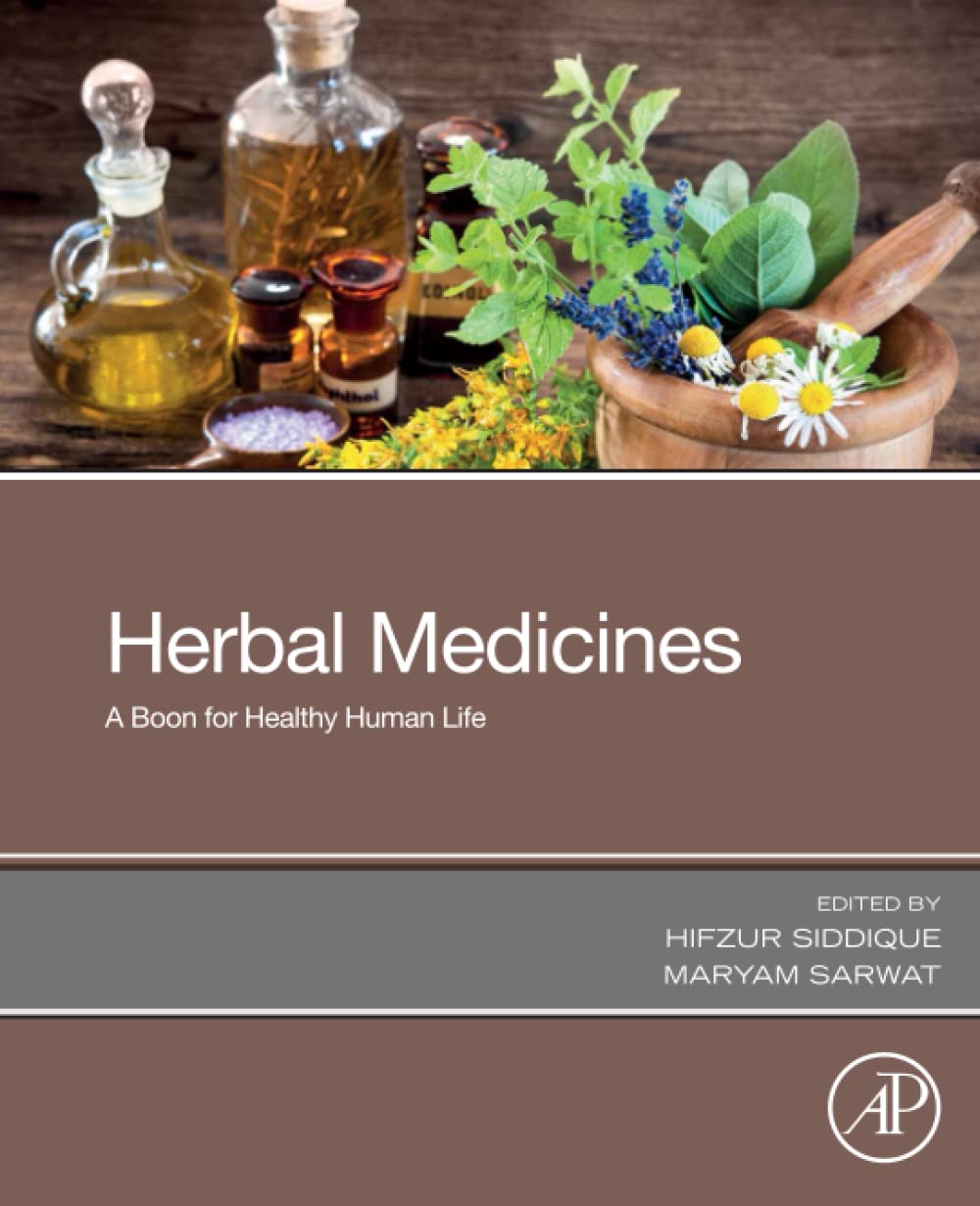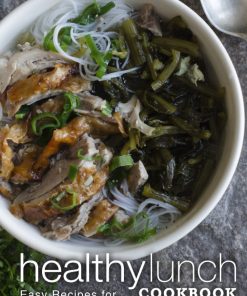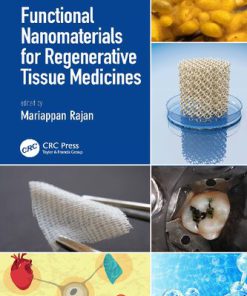Herbal Medicines A Boon for Healthy Human Life 1st Edition by Hifzur Siddique, Maryam Sarwat ISBN 9780323905725 0323905722
$50.00 Original price was: $50.00.$25.00Current price is: $25.00.
Herbal Medicines A Boon for Healthy Human Life 1st Edition by Hifzur Siddique, Maryam Sarwat – Ebook PDF Instant Download/Delivery: 9780323905725 ,0323905722
Full download Herbal Medicines A Boon for Healthy Human Life 1st Edition after payment

Product details:
ISBN 10: 0323905722
ISBN 13: 9780323905725
Author: Hifzur Siddique, Maryam Sarwat
Herbal Medicines: A Boon for Healthy Human Life provides a comprehensive overview of the role of herbal medicines for treating a broad variety of human diseases, from neurological disorders to cancer and major disorders such as infectious diseases, metabolic disorders, and more. Each chapter summarizes the current state and future direction of the use of herbal medicines against multiple diseases from a translational point-of-view, making this reference a valuable source of information for a large audience, including researchers and healthcare providers interested in the field of herbal remedies.
- Discusses essential evidence-based information about herbal medicines
- Provides an update to new discoveries and recent advances on the use of herbal medicines to treat multiple human diseases
- Includes information on clinical studies and covers all major medicinal compounds, including alkaloids, glycosides, polyphenols and terpenes
Herbal Medicines A Boon for Healthy Human Life 1st Edition Table of contents:
Part 1 Neurological disorders
Chapter 1 Herbal drugs an alternative medicine for the treatment of neurodegenerative diseases: Preclinical and clinical trial review
Abstract
1.1 Introduction
1.2 Herbal drugs formulations in preclinical trials
1.3 Conclusion
References
Chapter 2 Review on correlations between depression and nutritional status of elderly patients
Abstract
2.1 Introduction
2.2 Correlations between depression and nutritional status of elderly patients
2.3 Nutritional status of the elderly patients
2.4 Summary
References
Chapter 3 Herbal remedies against Huntington’s disease: Preclinical evidences and future directions
Abstract
3.1 Introduction
3.2 Anti-HD activity of crude/semi-purified plant fractions/extract
3.3 Anti-HD activity of plant derived natural compounds
3.4 Anti-HD activity of herbal formulations
3.5 Discussion
3.6 Conclusion
References
Chapter 4 Alternate medicinal approach for the treatment of depression/mood disorder
Abstract
4.1 Introduction
4.2 Role of herbal medicine in depression/mood disorder
4.3 Conclusion
References
Part 2 Oral health
Chapter 5 Leveraging microbicidal and immunosuppressive potential of herbal medicine in oral diseases
Abstract
5.1 Introduction
5.2 Therapeutic use of plant products on oral diseases
5.3 Molecular mechanisms of action of natural products against oral pathogens
5.4 Plant products and immunity boosting
5.5 Routinely used immune modulating plant products
5.6 Conclusions and future perspectives
References
Part 3 Metabolic disorders and overall health
Chapter 6 Herbal medicines for the treatment of metabolic syndrome
Abstract
6.1 Introduction
6.2 Epidemiology of metabolic syndrome
6.3 Pathogenesis of metabolic syndrome
6.4 Visceral adiposity
6.5 Insulin resistance
6.6 Inflammation
6.7 Current modern therapies for metabolic syndrome
6.8 Possible mechanism/s underlying the protective effects of herbal medicines in metabolic syndrome
6.9 Efficacy in clinical trials
6.10 Limitations of herbal medicines
6.11 Modern approaches to investigate for the molecular mechanisms of herbal medicines
References
Chapter 7 Pharmacological importance of the active molecule “guggulsterone” in overall human health
Abstract
7.1 Introduction
7.2 Therapeutic effects of guggulsterone
7.3 Conclusion and future perspectives
References
Chapter 8 Herbal medicines for diabetes: Insights and recent advancement
Abstract
8.1 Introduction
8.2 Herbal medicines of diabetes
8.3 Traditional herbal antidiabetic drugs
8.4 Herbal marketed formulations of diabetes mellitus
8.5 Recent advancement in herbal medicines of diabetes
8.6 Conclusion
References
Chapter 9 Diabetes — a metabolic disorder: Herbal medicines on rescue
Abstract
9.1 Introduction
9.2 Herbal plants as a remedy for diabetes (Fig. 9.1)
9.3 Herbal plants exhibiting multiple mode of action in management of diabetes (Fig. 9.2)
9.4 Conclusions
References
Chapter 10 Rheumatoid arthritis and alternative medicine
Abstract
10.1 Introduction
10.2 Medicinal herbs in arthritis
10.3 Herbal marketed formulations for rheumatoid arthritis
10.4 Conclusion
References
Chapter 11 Traditional nutritional and health practices to tackle the lifestyle diseases
Abstract
11.1 Introduction
11.2 Impact of lifestyle on an individual’s health
11.3 Lifestyle diseases: an emerging epidemic which needs urgent attention
11.4 Occupational lifestyle diseases
11.5 Lifestyle affecting pregnancy and lactation
11.6 Infertility
11.7 Ways to treat lifestyle disorders
11.8 Conclusion
References
Chapter 12 Ethnic foods and concentrates: Its role in health protection
Abstract
12.1 Introduction
12.2 Classification of ethnic food
12.3 Traditional and folkloric ethnic foods of different provinces of world
12.4 Religious ethnic foods
12.5 Role of spices in ethnic food
12.6 Food concentrates
12.7 Advantage and disadvantage of ethnic food
12.8 Conclusion
Acknowledgement
References
Chapter 13 Role of natural products as therapeutic option against nonalcoholic fatty liver disease
Abstract
13.1 Introduction
13.2 Underlying molecular mechanisms in natural product based therapeutic strategy against nonalcoholic fatty liver disease
13.3 Natural bioactive compounds against nonalcoholic fatty liver disease
13.4 Conclusion
Acknowledgements
Conflict of interest
References
Part 4 Skin disorders
Chapter 14 Herbal medicines and skin disorders
Abstract
14.1 Introduction
14.2 Psoriasis
14.3 Atopic dermatitis
14.4 Acne
14.5 Nonmelanoma skin cancers
14.6 Melanoma
14.7 Dermatophytosis
14.8 Herbal medicines in skin disorders
14.9 Herbal medicines in psoriasis
14.10 Herbal medicines in atopic dermatitis
14.11 Herbal medicines in acne
14.12 Herbal medicines in melanoma and nonmelanoma skin cancers
14.13 Herbal medicines in dermatophytosis
14.14 Conclusion
References
Chapter 15 Herbal medicine and common dermatologic diseases
Abstract
15.1 Introduction
15.2 Acne and herbal medicine
15.3 Atopic dermatitis and herbal medicine
15.4 Psoriasis and herbal medicine
15.5 Conclusion
References
Chapter 16 Role of herbal products as therapeutic agents against ultraviolet radiation-induced skin disorders
Abstract
16.1 Introduction
16.2 Herbs and phtoprotection
16.3 Plant bioactive molecules
16.4 Plant extracts
Acknowledgements
References
Chapter 17 On bioactive compounds and the endophyte community in medicinal plants: Bioprocessing nature’s abundance for skin disorder treatment
Abstract
17.1 Skin overview
Acknowledgements
Conflicts of Interest
References
Part 5 Reproductive disorders
Chapter 18 Future of herbal medicines in assisted reproduction
Abstract
18.1 Introduction
18.2 Men/male associated infertility and the herbal interventions
18.3 Women/female-associated infertility and herbal interventions
18.4 Conclusion
Acknowledgement
References
Chapter 19 Herbal medicine to cure male reproductive dysfunction
Abstract
19.1 Introduction
19.2 Herbal medicines
19.3 Male reproductive disorder
19.4 Conclusion
Conflict of Interest
Acknowledgment
References
Chapter 20 Polycystic ovarian syndrome: Causes and therapies by herbal medicine
Abstract
20.1 Introduction
20.2 Pathophysiology
20.3 Genetic and epigenetic basis of polycystic ovarian syndrome
20.4 Therapeutic approaches
20.5 Alternative medicines
20.6 Concluding remarks
References
Part 6 Infectious diseases
Chapter 21 Emerging natural product based alternative therapeutics for tuberculosis
Abstract
21.1 Introduction: Recent directions in the therapeutics for tuberculosis and underlying challenges
21.2 Recent development in natural product based alternative tuberculosis therapeutic options
21.3 Candidate natural products and their derivatives for alternative tuberculosis therapy
References
Chapter 22 Unraveling of inhibitory potential of phytochemicals against SARS-CoV-2 using in-silico approach
Abstract
22.1 Introduction
22.2 Overview of SARS-CoV-2 structure and infection
22.3 COVID-19 vaccines v/s anti-SARS-Cov-2 phytochemicals
22.4 Molecular docking and simulations
22.5 Screening of potential anti-SARS-CoV-2 phytochemicals using in-silico approach
22.6 Conclusion
Contribution
Acknowledgment
References
Chapter 23 Ethnopharmacological reports on herbs used in the management of tuberculosis
Abstract
23.1 Introduction
23.2 Rationale behind herbal treatment over regular treatment
23.3 Conclusion
References
Part 7 Cardiovascular disorders
Chapter 24 Cardiovascular disorders and herbal medicines in India
Abstract
24.1 Introduction
24.2 Cardiovascular disease and disorders
24.3 Major risk factors for cardiovascular disease
24.4 Herbal treatment
24.5 Indian medicinal plants (used for cardiovascular disease management)
24.6 Medicinal plants and cardiovascular disease
24.7 Conclusions
References
Part 8 Cancer
Chapter 25 Targeting metabolism with herbal therapy: A preventative approach toward cancer
Abstract
25.1 Introduction
25.2 Major targets of metabolic reprogramming in malignant cells
25.3 Herbal compounds in modulating cancer metabolic reprogramming
25.4 Clinical studies on the use of herbal compounds in cancer management
25.5 Conclusions
Acknowledgment
Conflict of Interest
References
Chapter 26 An introduction to herbal medicines and palliative care of cancer patients and related diseases through times in Turkey
Abstract
26.1 Introduction
26.2 The pattern of prescribing medicines through time
26.3 Some important physicians during the Arab period
26.4 Turkish medical systems in Anatolia
26.5 Hospitals and teaching of medicine
26.6 Post World War I period and democracy
26.7 Palliative care system
26.8 The general and oncologists approaches
26.9 Concern about erosion of ethnomedicinal knowledge about plants
26.10 Need of documentation with mutidisciplinery approach
26.11 Therapeutic value
26.12 Conclusions
References
Chapter 27 Effects of Amygdalin on prostate cancer
Abstract
27.1 Introduction
27.2 Materials and methods
27.3 Discussion
References
Chapter 28 Protective effects of plant-derived natural products against hepatocellular carcinoma
Abstract
28.1 Introduction
28.2 Oxidative stress and capturing it to prevent hepatocellular carcinoma
28.3 Apoptosis and antiapoptotic treatment to prevent hepatocellular carcinoma
28.4 Inflammation and anti-inflammatory herbal drugs to prevent hepatocellular carcinoma development
28.5 Hepatitis B, C infection and treatment to prevent hepatocellular carcinoma development
28.6 Cytotoxic agents, apoptosis, and hepatocellular carcinoma
28.7 Other herbal management
28.8 Conclusions and future perspectives
Conflict of interest
Acknowledgment
References
Chapter 29 Herbal medicines and bladder cancer
Abstract
29.1 Bladder cancer
29.2 Therapeutic advances in bladder cancer
29.3 Complementary and alternative medicine for bladder cancer
29.4 Korean medicine against bladder cancer
29.5 Case reports of urothelial bladder cancer patients treated with Korean medicine
29.6 Chinese herbal therapy for bladder cancer
29.7 Frankincense oil in bladder cancer treatment
29.8 Other herbal remedies used in bladder cancer treatment
References
Chapter 30 Mixed effects and mechanisms of cannabinoids for triple-negative breast cancer treatment
Abstract
30.1 Introduction
30.2 Classification of breast cancer
30.3 Triple-negative breast cancer
30.4 Marijuanna-derived compounds
30.5 Cannabinoid receptors
30.6 Anticancer effects of cannabinoids in triple-negative breast cancer
30.7 Cellular mechanisms of anticancer effects of cannabinoids
30.8 Molecular mechanisms of cannabinoids
30.9 Mixed actions of cannabinoids in other cancer types
References
Part 9 Concern
Chapter 31 A sound comprehension of molecular biology and relevant biotechnology is a prerequisite for research on the molecular mechanisms of traditional Chinese medicine, mainly medicinal herbs
Abstract
31.1 Introduction
31.2 There are unsolved problems in translation of traditional Chinese medicine theory into the western medicine language
31.3 One gene has many RNA and protein products
31.4 Most published traditional Chinese medicine studies do not address the issue of RNA or protein multiplicity
31.5 Many traditional Chinese medicine studies do not consider technical pitfalls in common methods for DNA and RNA analyses
31.6 Signaling transduction networking is even more intricate and its studies are more problematic
31.7 Traditional Chinese medicine professionals have an innate disadvantage in translating traditional Chinese medicine theory into the western medicine language
31.8 How should the above mentioned constraints be vanquished to advance traditional Chinese medicine?
31.9 Conclusions
References
Index
People also search for Herbal Medicines A Boon for Healthy Human Life 1st Edition:
is herbal medicine safe
is herbal medicine legitimate
is herbal medicine real
the lost book of herbal remedies on amazon
herbal medicine amazon
Tags: Hifzur Siddique, Maryam Sarwat, Herbal Medicines, Healthy Human Life
You may also like…
Relationships & Lifestyle - Health - Diseases & Disorders
Living a Healthy Life with Chronic Pain Getting Your Life Back Second Edition, 2Nd Edition Lefort
Uncategorized
Biography & Autobiography - Social & Health Issues
Healthy Urban Environments More than Human Theories 1st Edition Cecily Maller
Relationships & Lifestyle - Diet & Nutrition
Human Nutrition : Science for Healthy Living 3rd Edition Tammy J. Stephenson
Medicine - Natural Medicine
Traditional Herbal Therapy for the Human Immune System 1st Edition Azamal Husen
Relationships & Lifestyle - Exercise & Fitness
LOSE FAT GET FITTR THE SIMPLE SCIENCE OF STAYING HEALTHY FOR LIFE First Edition Jitendra Chouksey











